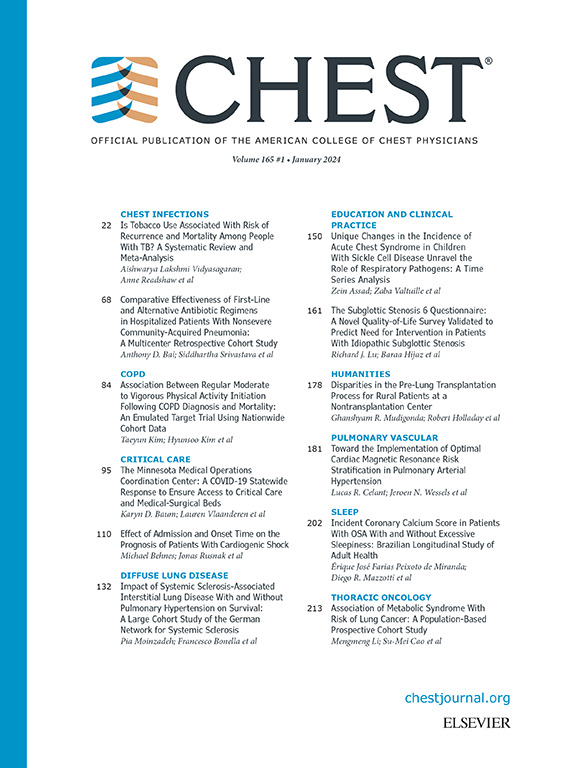Clinical impact of tirzepatide on patients with obstructive sleep apnea and obesity.
IF 9.5
1区 医学
Q1 CRITICAL CARE MEDICINE
引用次数: 0
Abstract
BACKGROUND Obstructive sleep apnea (OSA) is a prevalent chronic condition linked to obesity and associated with increased risks of cardiovascular and kidney disease. While weight loss can improve OSA outcomes, additional effective therapeutic options are needed. Tirzepatide, a dual glucose-dependent insulinotropic polypeptide and glucagon-like peptide-1 receptor agonist, has shown promise in promoting significant weight loss and reducing OSA severity. RESEARCH QUESTION Does tirzepatide affect clinical outcomes in individuals with OSA and obesity? STUDY DESIGN AND METHODS This study was conducted using the TriNetX Global Collaborative Network and included adults with OSA and obesity between January 1, 2022, and November 30, 2024. Patients were divided into two groups: those prescribed tirzepatide (study group) and those receiving lifestyle interventions (control group). Propensity score matching (PSM) was applied to balance covariates. The primary outcome was all-cause mortality, with secondary outcomes including major adverse cardiovascular events (MACE) and major adverse kidney events (MAKE). RESULTS After PSM, the study included 42,300 patients (21,150 in each group). The tirzepatide group was associated with a lower risk of all-cause mortality (HR, 0.443; 95% CI, 0.336-0.583). Tirzepatide use was also associated with reduced risks of MACE (HR, 0.731; 95% CI, 0.622-0.859) and MAKE (HR, 0.427; 95% CI, 0.343-0.530). Except for the 18-39 age group, these associations remained consistent across all other subgroups when stratified by age, sex, body mass index, and continuous positive airway pressure use. Sensitivity analyses supported the robustness of these findings. INTERPRETATION Tirzepatide could be associated with reduced mortality, cardiovascular events, and kidney-related complications in patients with OSA and obesity. These findings suggest that tirzepatide may be a potential therapeutic option for improving clinical outcomes in this population.替扎帕肽对阻塞性睡眠呼吸暂停和肥胖症患者的临床影响。
背景:阻塞性睡眠呼吸暂停(OSA)是一种常见的慢性疾病,与肥胖有关,并与心血管和肾脏疾病的风险增加有关。虽然减肥可以改善阻塞性睡眠呼吸暂停的结果,但还需要其他有效的治疗方案。tizepatide是一种双重葡萄糖依赖性胰岛素性多肽和胰高血糖素样肽-1受体激动剂,已显示出促进显著减肥和降低OSA严重程度的希望。研究问题:替西肽是否会影响OSA和肥胖患者的临床结局?研究设计和方法本研究使用TriNetX全球协作网络进行,纳入了2022年1月1日至2024年11月30日期间患有OSA和肥胖症的成年人。患者分为两组:服用替西帕肽的患者(研究组)和接受生活方式干预的患者(对照组)。使用倾向得分匹配(PSM)来平衡协变量。主要结局是全因死亡率,次要结局包括主要不良心血管事件(MACE)和主要不良肾脏事件(MAKE)。结果PSM后,研究纳入42,300例患者(每组21,150例)。替西帕肽组全因死亡风险较低(HR, 0.443;95% ci, 0.336-0.583)。替西帕肽的使用也与MACE风险降低相关(HR, 0.731;95% CI, 0.622-0.859)和MAKE (HR, 0.427;95% ci, 0.343-0.530)。除18-39岁年龄组外,在按年龄、性别、体重指数和持续气道正压通气分层时,这些关联在所有其他亚组中保持一致。敏感性分析支持这些发现的稳健性。替西帕肽可能与OSA和肥胖患者的死亡率、心血管事件和肾脏相关并发症的降低有关。这些发现表明替西肽可能是改善该人群临床结果的潜在治疗选择。
本文章由计算机程序翻译,如有差异,请以英文原文为准。
求助全文
约1分钟内获得全文
求助全文
来源期刊

Chest
医学-呼吸系统
CiteScore
13.70
自引率
3.10%
发文量
3369
审稿时长
15 days
期刊介绍:
At CHEST, our mission is to revolutionize patient care through the collaboration of multidisciplinary clinicians in the fields of pulmonary, critical care, and sleep medicine. We achieve this by publishing cutting-edge clinical research that addresses current challenges and brings forth future advancements. To enhance understanding in a rapidly evolving field, CHEST also features review articles, commentaries, and facilitates discussions on emerging controversies. We place great emphasis on scientific rigor, employing a rigorous peer review process, and ensuring all accepted content is published online within two weeks.
 求助内容:
求助内容: 应助结果提醒方式:
应助结果提醒方式:


